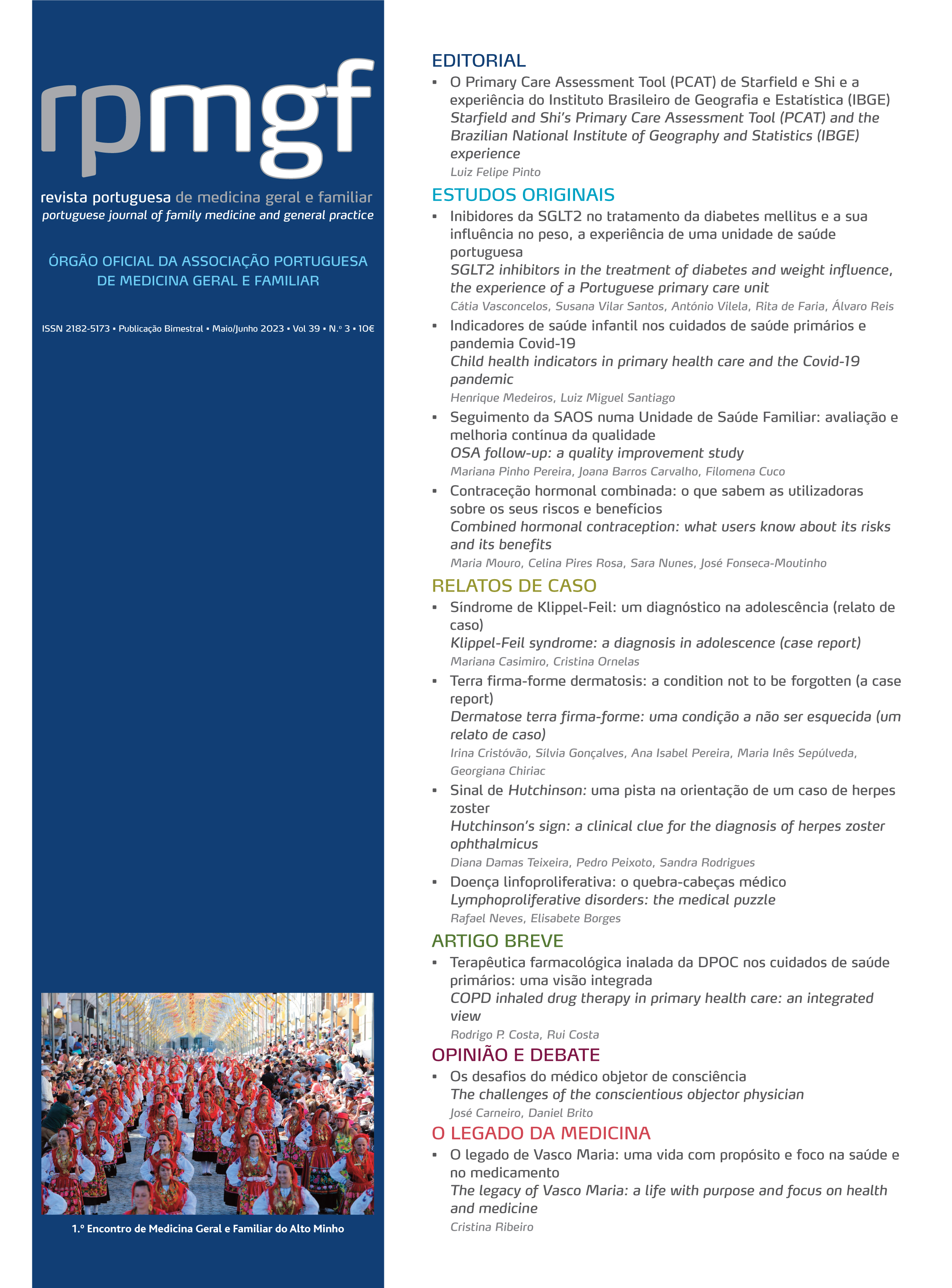Klippel-Feil syndrome: a diagnosis in adolescence (case report)
DOI:
https://doi.org/10.32385/rpmgf.v39i3.13597Keywords:
Klippel-Feil syndrome, Renal agenesis, Bicuspid aortic valve disease, Case reportAbstract
Introduction: Klippel-Feil syndrome (KFS) is a disease that predominantly affects the spine leading to the fusion of vertebrae. In addition, defects in other systems are described, namely cardiovascular, renal, among others. This clinical case reports part of these changes and aims to raise awareness of this pathology and its comorbidities for the medical community. It also intends to highlight the role of the family doctor (FD) in the follow-up of the patient and his family.
Case description: 15-year-old male with no relevant medical history complains of neck and chest pain with rotation and flexion of the cervical thoracic spine. Physical examination reveals a short neck, low hairline implantation, scoliosis, cervical kyphosis, and lumbar spine straightening. Spinal CT shows fusion of several cervical and lumbar vertebrae. The hypothesis of KFS is raised and other associated malformations are investigated identifying: agenesis of the right kidney and vicarious left kidney, palatal atresia, and bicuspid aortic valve. The FD establishes contact with various specialties to create the ideal therapeutic plan.
Comment: This case portrays the process of diagnosis and follow-up of an adolescent suspected of having a rare syndrome with osteoarticular, renal, cardiovascular, and palatine involvement. Throughout this process, the FD was the health care manager. The longitudinal support provided to the patient and his family was essential to overcome periods of uncertainty and fragility. It is expected that in the future, osteoarticular structural abnormalities may cause functional limitations, with a consequent reduction on his quality of life. This process has been discussed with the patient and his family to create strategies to prevent future comorbidities and to improve quality of life with physical rehabilitation.
Downloads
References
Frikha R. Klippel-Feil syndrome: a review of the literature. Clin Dysmorphol. 2020;29(1):35-7.
Tracy MR, Dormans JP, Kusumi K. Klippel-Feil syndrome: clinical features and current understanding of etiology. Clin Orthop Relat Res. 2004;(424):183-90.
Litrenta J, Bi AS, Dryer JW. Klippel-Feil syndrome: pathogenesis, diagnosis and management. J Am Acad Orthop Surg. 2021;29(22):951-60.
O’Donnel DP, Seupaul RA. Klippel-Feil syndrome. Am J Emerg Med. 2008;26(2):252.e1-2.
Vaidyanathan S, Hughes PL, Soni BM, Singh G, Sett P. Klippel-Feil syndrome – The risk of cervical spinal cord injury: a case report. BMC Fam Pract. 2002;3:6.
McBride WZ. Klippel-Feil syndrome. Am Fam Physician. 1992;45(2):633-5.
Thompson E, Haan E, Sheffield L. Autosomal dominant Klippel-Feil anomaly with cleft palate. Clin Dysmorphol. 1998;7(1):11-5.
Goto M, Nishimura G, Nagai T, Yamazawa K, Ogata T. Familial Klippel-Feil anomaly and t(5;8)(q35.1;p21.1) translocation. Am J Med Genet A. 2006;140(9):1013-5.
Downloads
Published
Issue
Section
License
Copyright (c) 2023 Portuguese Journal of Family Medicine and General Practice

This work is licensed under a Creative Commons Attribution-NonCommercial-NoDerivatives 4.0 International License.
The authors will assign to the RPMGF the sole right to publish and distribute the content of the manuscript specified in this declaration via physical, electronic, broadcasting or any other medium that may come into existence. They also grant the RPMGF the right to use and exploit this manuscript, in particular by assigning, selling or licensing its content. This permission is permanent and takes effect from the moment the manuscript is submitted, has the maximum duration allowed by applicable Portuguese or international law and is of worldwide scope. The authors further declare that this assignment is made free of charge. If the RPMGF informs the authors that it is not going to publish their manuscript, the exclusive assignment of rights ceases forthwith.
The authors authorise the RPMGF (or any entity it may appoint) to act on their behalf when it believes that copyright may have been infringed.





